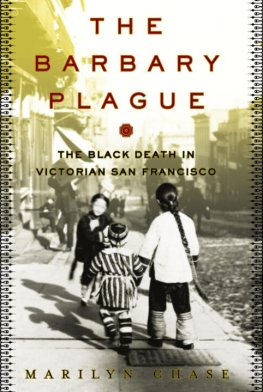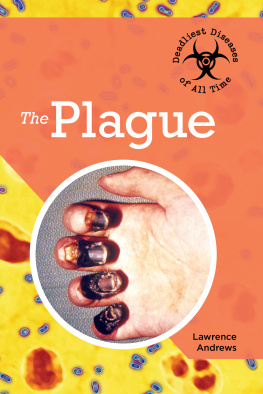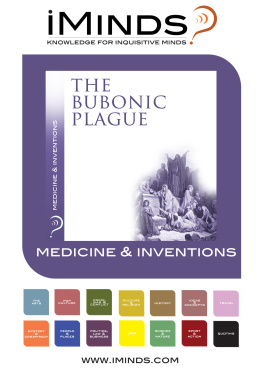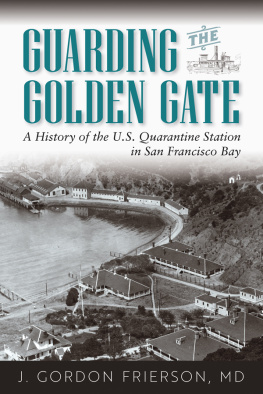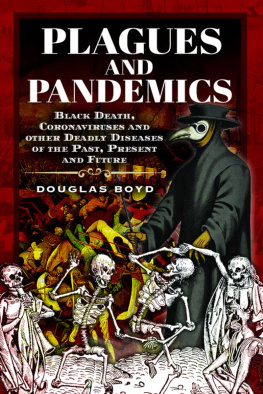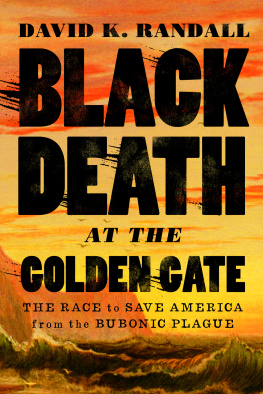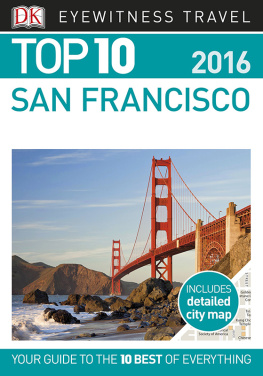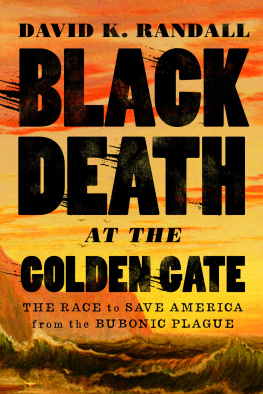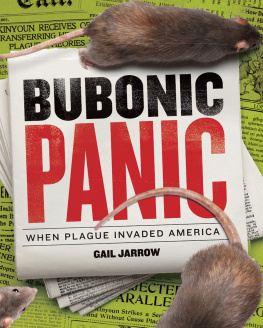Marilyn Chase
THE BARBARY PLAGUE
The Black Death in Victorian San Francisco
For Randy, Jack, and Becca


SAN FRANCISCO IN 1900 was a Gold Rush boomtown settling into a gaudy middle age. Fifty years earlier, it had been a miners camp pitched upon sand dunes. Now it had a pompous new skyline with skyscrapers nearly twenty stories tall, grand hotels, and Victorian mansions on Nob Hill. Cable cars scaled its hills on chains that jingled like the necklace on a vaudeville soubrette. The city filled three opera houses with the zeal of the nouveaux riches. But underneath its ermine opera cape beat the heart of its rowdy past: the old Barbary Coast was still alive in the saloons and vaudevilles, bawdy houses and French restaurants, with dining downstairs and women upstairs.
Keening seagulls rode the cool currents of fog and sun, circling town with their rusty cries. At street level, the city (while eager to embrace electricity and motorcars) still lived on gaslight and horsepower. Horse-drawn buggies and streetcars rattled west from downtown, past churches, temples, and sandlots, toward Ocean Beach. The oblique slash of Market Street bisected the town, running from southwest to northeast, from Castro Street, past the dome of City Hall, past the Palace Hotel, past the Emporium and Golden Rule Bazaar department store, and finally ending at the waters edge, where the Ferry Buildings clock tower was a travelers first view of the city.
The wharf bristled with masts and smokestacks from as many as a thousand sailing ships and steamers arriving each year. To guide their passage through the fog, lighthouses pulsed from every promontory. Decades before modern foghorns, each island in the bayAngel Island, Alcatraz, and Yerba Buenahad its own sound signature from fog bells, ships whistles, sirens, or chimes. On foggy days, the bay must have sounded like an antique calliope, playing its strange music to guide ships captains through corridors of mist to a safe harbor.1
But the harbor would not be safe for long. Across the Pacific came an unexpected import, bubonic plague. Sailing from China and Hawaii into the unbridged arms of the Golden Gate, it arrived aboard vessels bearing rich cargoes, hopeful immigrants, and infected vermin. The rats slipped out of their shadowy holds, scuttled down the rigging, and alighted on the wharf. Uphill they scurried, insinuating themselves into the heart of the city.
Two doctors in federal uniformJoseph Kinyoun and Rupert Bluewould each try in his own way to quell the pestilence. One doctor would try to subdue the outbreak from his laboratory at the quarantine station on Angel Island. The other doctor would work at street level, purging the infection from boardwalk to basement. The public health efforts of the day were handicapped by limited scientific knowledge and bedeviled by the twin demons of denial and discrimination. One man would fail, and the other would succeed to become the top physician in the land. Today, few people know their names. But their mission would foreshadow the challenges posed by epidemics for the century to come.
When plague hit, one doctor would later recall, We were fighting in the dark. The scientists were an unwelcome presence in the city by the Golden Gate. Turn-of-the-century San Francisco aspired to be not a plague zone, but the Paris of the Pacific. Its mayor, James Phelan, a proponent of the City Beautiful movement, sought to build its civic center into a Beaux Arts showplace. In industry, the city was proud to be the shipping power of the Pacific Coast and the western transit center for the U.S. military. As evidenced by the citys motto, Gold in peace, iron in war, San Franciscos fortunes were forged to metal, bright or dull. Its tycoons got rich by mining ore from the hills and building great banking houses in its financial district. Later, ironworks and shipbuilders kept the city afloat by supplying warships for the Spanish-American War in the Philippines.2
The Spirit of 1900, in a Chronicle newspaper artists rendering, depicted the goddess of progress operating a railroad, a telegraph, and a dynamo engine. San Franciscans embraced this ethic of progress, damming the Hetch Hetchy River and razing the Tahoe forest for power and building materialand drawing protests from the aging John Muir and his infant Sierra Club. From boardrooms to church pulpits, the city cheered the Spanish-American conflict as a boon to its economy. As the Union Iron Works and the Southern Pacific Railroad went, so went the city. Sons of the Gold Rush, San Franciscans styled themselves as a new breed of Argonauts, explorers and executors of manifest destiny.3
If the East had the Astors, Carnegies, and Mellons, San Francisco had the Big Four railroad baronsHopkins, Huntington, Crocker, and Stanfordwho clustered their palazzi on Nob Hill like Renaissance princes occupying a Tuscan hill town. Soon, other industrialists followed them, abandoning the south of Market Street for the fresher climes of Nob Hill and Pacific Heights, where their mansions mushroomed in a hodgepodge of architectural stylesItalian Renaissance, French baroque, Victorian, Edwardian, and Queen Anneall elbowing one another for supremacy.
On sunny weekends, a caravan of horse buggies, landaus, calches, and a few rattletrap automobiles faced into the wind, rambling west through Golden Gate Park, whose green carpet replaced the sand dunes and tamed the sandstorms that once scoured the citys western fringes. Gliding through the canopy of manicured greenery, the day-trippers rolled on to the gingerbread castle of Cliff House, a wooden Victorian restaurant perched on a promontory overlooking the breakers of the Pacific Ocean and barking sea lions on Seal Rock. Their destination reached, the caravan turned and rolled home, merry and windburned, ahead of the fog that blew in from the west. The weekly parade lasted all day.4
Strollers ambled on Market, Montgomery, or Kearny Street. Men wore broad-shouldered tweeds and bowlers. Ladies, corseted into breathless figure eights, swept past in day gowns of ecru, coral, and celestial blue from fine stores like the White House or the City of Paris. Picture hats resembling platters of meringue and Tuscan straw bonnets were all the rage, crowned with sprays of heliotrope, bunches of cherries, or egret feathers in a nest of net. Sailor-suited children, sated with peanuts and French caramels, trailed their parents home from the matinee.5
At home, supper waited. In those days, Kona coffee cost 20 cents a pound, ocean fish went for 12 cents a pound, California figs were four pounds for a quarter. Sourdough bread, the Gold Rush staple, cost a dime for two loaves.
Theaters were packed, and there was a spectacle for every taste, from a staging of Mark Twains Puddnhead Wilson to a piano recital by Paderewski. There was a French farce at the Alcazar Theatre. The dashing maestro Walter Damrosch conducted The Flying Dutchman at the opera house. Golden youth of the upper classes waltzed demurely at the Greenway balls and the La Jeunesse Cotillions. Showgirls and young swells danced the buck and wing.
Once the tycoons migrated to Nob Hill, the working class took over the sunny triangle south of Market Street, turning it from a fashionable neighborhood into a utilitarian zone of boardinghouses and flats. There, a good time was the penny vaudeville or, better yet, free amateur night at Kapp & Streets Tamale Grotto and Refined Concert Hall, a Market Street establishment that advertised itself as A Strictly First-Class Vaudeville Show. In some ways, the town itself was a vaudeville show. But those abandoned by the boomtown often ended their misery with a searing gulp of carbolic acid or an open gaslight jet with the keyhole stuffed tight. For those who survived their misfortune, the last resort was the almshouse on the foggy, windward side of Twin Peaks.

